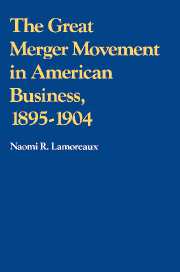Book contents
- Frontmatter
- Contents
- Acknowledgments
- List of tables and figures
- 1 Introduction
- 2 Product differentiation, mass production, and the urge to merge: competitive strategies and collusion in the late nineteenth century
- 3 High fixed costs and rapid expansion: a model of price warfare and two examples
- 4 Quantitative and qualitative evidence on the great merger movement
- 5 What changed? The impact of consolidations on competitive behavior
- 6 The great merger movement and antitrust policy
- 7 Conclusion
- Bibliographical essay
- Index
4 - Quantitative and qualitative evidence on the great merger movement
Published online by Cambridge University Press: 01 April 2010
- Frontmatter
- Contents
- Acknowledgments
- List of tables and figures
- 1 Introduction
- 2 Product differentiation, mass production, and the urge to merge: competitive strategies and collusion in the late nineteenth century
- 3 High fixed costs and rapid expansion: a model of price warfare and two examples
- 4 Quantitative and qualitative evidence on the great merger movement
- 5 What changed? The impact of consolidations on competitive behavior
- 6 The great merger movement and antitrust policy
- 7 Conclusion
- Bibliographical essay
- Index
Summary
My explanation for the great merger movement can now be stated explicitly. Manufacturers formed consolidations to escape the severe price competition that developed during the depression of the nineties in certain types of industries: capital-intensive, mass-production industries in which firms were closely matched and in which expansion had been rapid on the eve of the Panic of 1893. In these industries, not only did firms have extensive capital investments, but also they were new firms and thus most likely to be pressured by high fixed charges. As a result, they were particularly susceptible to the temptation to cut prices and struggle for a greater share of the market when falling demand sent prices tumbling below total costs. Moreover, in such industries manufacturers were also most likely to risk cutting prices. Firms were new; marketing patterns and customer loyalties were not yet established; the ability of competitors to respond to price cuts was not yet known. The very newness of the firms, the fact that the industry was in a state of flux, made price warfare all the more likely.
The quantitative evidence
This rapid growth hypothesis satisfactorily accounts for the different behaviors of wire-nail producers and rail producers during the 1890s and for the formation of a consolidation in the former industry but not in the latter. The extent to which it also explains the pattern of consolidations in the manufacturing sector as a whole can be assessed using data collected by the U. S. Census Office and the list of consolidations Ralph L. Nelson compiled for his study of industrial mergers.
- Type
- Chapter
- Information
- The Great Merger Movement in American Business, 1895–1904 , pp. 87 - 117Publisher: Cambridge University PressPrint publication year: 1985



